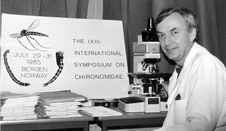Obituary for Ole Anton Sæther
Professor emeritus Ole Anton Sæther will be missed at the University Museum and by friends and colleagues in many countries
By Endre Willassen The news of professor emeritus Ole A. Sæther's passing in January didn't come as a surprise for those of us who knew of his struggle with cancer. But last fall, after a period of sick leave, with repeated cell cures, he returned to his microscope and countless microscopic preparations at his workplace in a pensioners home. He had expressed hope of being able furthering his professional passion without professorale duties in another few years. Unfortunately, it did not happen as hoped.
The news of professor emeritus Ole A. Sæther's passing in January didn't come as a surprise for those of us who knew of his struggle with cancer. But last fall, after a period of sick leave, with repeated cell cures, he returned to his microscope and countless microscopic preparations at his workplace in a pensioners home. He had expressed hope of being able furthering his professional passion without professorale duties in another few years. Unfortunately, it did not happen as hoped.
Ole Anton Sæther was born in 1936. After his studies at the University of Oslo he was appointed as a research assistant at the Institute of Limnology there in 1961. It was during research of the ecological conditions in Østensjøvann that his interest in the ecologically important dipteran family of Chironomidae began, and would become his particular fascination for the rest of his life. It was through an especially colossal production of taxonomic descriptions of species from all over the world that he became renowned in scientific circles of freshwater ecology.
After completing the degree cand. real. in 1963, Ole was appointed University lecturer's at the University of Oslo until 1969. During this period, he was a guest researcher at the Freshwater Institute of the Fisheries Research Board in Winnipeg, Canada, where from 1969 he became a full-time researcher in charge of the study of organic contamination of benthic species and freshwater resources.
During his years in Canada, he produced a large number of scientific publications and, during this period, became a proponent of Willi Hennig's school of phylogenetic methods. These were based on ideas about how evolutionary relationship between species can be reconstructed by systematic studies. Through identifying commonalities at the given unique species, Hennig's synapomorphies, one could construct with clear evidence hypotheses of common ancestry and derive phylogenetic relationships for the different organism groups. These kinds of progenitor trees would form the basis of classifications of species diversity, a more scientific method than the "intuitive" nature of previous traditional methods of classifications.
When Sæther received in 1977 tenure as a professor at the University of Copenhagen Zoological Museum at the University of Bergen, he became passionate in the debates between different schools in systematic theory. The new Professor's inclusion of so-called cladistic philosophy into the curriculum inspired students to consciously thinking about the basis for classifications and how these, in different ways, inter alia, with the question of evolution and the historical understanding of the diversity and our natural environment. Further, they could be identified and which environmental states the various species seemed preferable, also introduced new perspectives and practical applications. Changes in species composition in space and time can be used in the monitoring of environmental conditions in fresh water, and especially in recent years, reconstruction of climate and other conditions based on the remains of chironomidae in the live cores almost become the industry in environmental research.
He was a popular teacher in entomology, freshwater ecology, and animal geography at the Museum's annual field course in Rosendal and Jutland. His Alumni graduates from University of Bergen are in different professions, not only in Norway but also in our neighbouring countries. But his view was world-wide, and he also brought the world to the University of Bergen through his international network of contacts. He also took students from other parts of the world, long before globalization became a research bureaucratic fashion word. So he, too, received by collectors in exotic climes, access to new branches on the feathered myggenes family tree. Over the years, students from Africa, Latin America and China obtained their academic degrees at the University of Bergen after their studies with Ole Sæther.
He was responsible for the description and naming of newly discovered species, close to 400, mostly of the Chironomidae but also other insects and mites. His overall body of work approached 250 scientific works published in journals and books. He was also co-author of electronic publications. A search of the family Chironomidae at Fauna Europaea website counts 71 species of chironomidae in Europe and 545 in Norway. Ole Sæther had numbers on such. Right to the end he retained his high release rate and had what was to be done by hand in progress work. But he may rest in peace. Ole A. Sæther has left deep traces in the scientific literature. They will be visible forever, at least among those of us who have opportunities to see greatness in existence through mikroskopets eyepieces.
Sæther will be missed at the University Museum and by friends and colleagues in many countries.
source: http://nyheter.uib.no/?modus=vis_nyhet&id=52372 (based on a computer translation from Norwegian)
Last Update: Monday, 24-Feb-2014